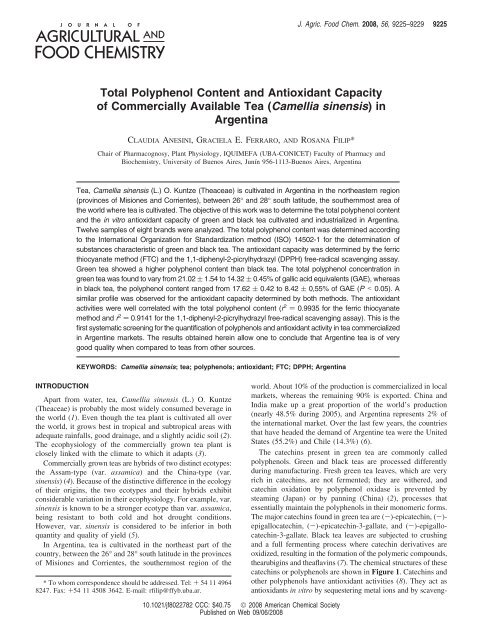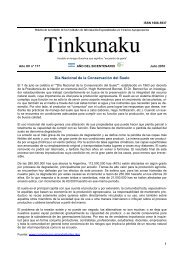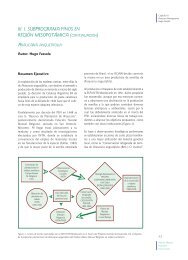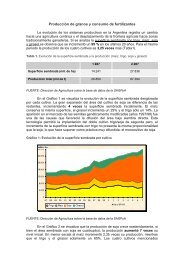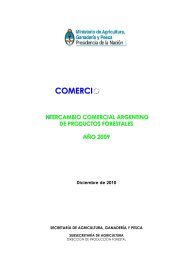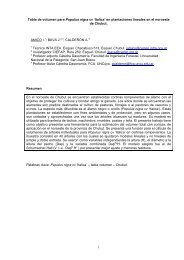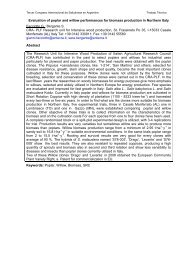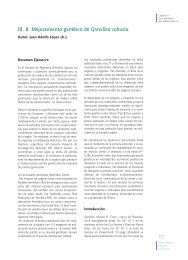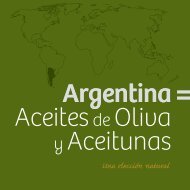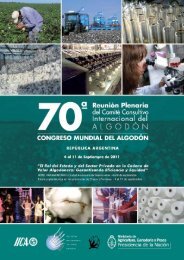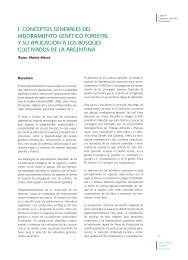Total Polyphenol Content and Antioxidant Capacity of Commercially ...
Total Polyphenol Content and Antioxidant Capacity of Commercially ...
Total Polyphenol Content and Antioxidant Capacity of Commercially ...
You also want an ePaper? Increase the reach of your titles
YUMPU automatically turns print PDFs into web optimized ePapers that Google loves.
J. Agric. Food Chem. 2008, 56, 9225–9229 9225<strong>Total</strong> <strong>Polyphenol</strong> <strong>Content</strong> <strong>and</strong> <strong>Antioxidant</strong> <strong>Capacity</strong><strong>of</strong> <strong>Commercially</strong> Available Tea (Camellia sinensis) inArgentinaCLAUDIA ANESINI, GRACIELA E. FERRARO, AND ROSANA FILIP*Chair <strong>of</strong> Pharmacognosy, Plant Physiology, IQUIMEFA (UBA-CONICET) Faculty <strong>of</strong> Pharmacy <strong>and</strong>Biochemistry, University <strong>of</strong> Buenos Aires, Junín 956-1113-Buenos Aires, ArgentinaTea, Camellia sinensis (L.) O. Kuntze (Theaceae) is cultivated in Argentina in the northeastern region(provinces <strong>of</strong> Misiones <strong>and</strong> Corrientes), between 26° <strong>and</strong> 28° south latitude, the southernmost area <strong>of</strong>the world where tea is cultivated. The objective <strong>of</strong> this work was to determine the total polyphenol content<strong>and</strong> the in vitro antioxidant capacity <strong>of</strong> green <strong>and</strong> black tea cultivated <strong>and</strong> industrialized in Argentina.Twelve samples <strong>of</strong> eight br<strong>and</strong>s were analyzed. The total polyphenol content was determined accordingto the International Organization for St<strong>and</strong>ardization method (ISO) 14502-1 for the determination <strong>of</strong>substances characteristic <strong>of</strong> green <strong>and</strong> black tea. The antioxidant capacity was determined by the ferricthiocyanate method (FTC) <strong>and</strong> the 1,1-diphenyl-2-picrylhydrazyl (DPPH) free-radical scavenging assay.Green tea showed a higher polyphenol content than black tea. The total polyphenol concentration ingreen tea was found to vary from 21.02 ( 1.54 to 14.32 ( 0.45% <strong>of</strong> gallic acid equivalents (GAE), whereasin black tea, the polyphenol content ranged from 17.62 ( 0.42 to 8.42 ( 0,55% <strong>of</strong> GAE (P < 0.05). Asimilar pr<strong>of</strong>ile was observed for the antioxidant capacity determined by both methods. The antioxidantactivities were well correlated with the total polyphenol content (r 2 ) 0.9935 for the ferric thiocyanatemethod <strong>and</strong> r 2 ) 0.9141 for the 1,1-diphenyl-2-picrylhydrazyl free-radical scavenging assay). This is thefirst systematic screening for the quantification <strong>of</strong> polyphenols <strong>and</strong> antioxidant activity in tea commercializedin Argentine markets. The results obtained herein allow one to conclude that Argentine tea is <strong>of</strong> verygood quality when compared to teas from other sources.KEYWORDS: Camellia sinensis; tea; polyphenols; antioxidant; FTC; DPPH; ArgentinaINTRODUCTIONApart from water, tea, Camellia sinensis (L.) O. Kuntze(Theaceae) is probably the most widely consumed beverage inthe world (1). Even though the tea plant is cultivated all overthe world, it grows best in tropical <strong>and</strong> subtropical areas withadequate rainfalls, good drainage, <strong>and</strong> a slightly acidic soil (2).The ecophysiology <strong>of</strong> the commercially grown tea plant isclosely linked with the climate to which it adapts (3).<strong>Commercially</strong> grown teas are hybrids <strong>of</strong> two distinct ecotypes:the Assam-type (var. assamica) <strong>and</strong> the China-type (var.sinensis)(4). Because <strong>of</strong> the distinctive difference in the ecology<strong>of</strong> their origins, the two ecotypes <strong>and</strong> their hybrids exhibitconsiderable variation in their ecophysiology. For example, var.sinensis is known to be a stronger ecotype than var. assamica,being resistant to both cold <strong>and</strong> hot drought conditions.However, var. sinensis is considered to be inferior in bothquantity <strong>and</strong> quality <strong>of</strong> yield (5).In Argentina, tea is cultivated in the northeast part <strong>of</strong> thecountry, between the 26° <strong>and</strong> 28° south latitude in the provinces<strong>of</strong> Misiones <strong>and</strong> Corrientes, the southernmost region <strong>of</strong> the* To whom correspondence should be addressed. Tel: + 54 11 49648247. Fax: +54 11 4508 3642. E-mail: rfilip@ffyb.uba.ar.world. About 10% <strong>of</strong> the production is commercialized in localmarkets, whereas the remaining 90% is exported. China <strong>and</strong>India make up a great proportion <strong>of</strong> the world’s production(nearly 48.5% during 2005), <strong>and</strong> Argentina represents 2% <strong>of</strong>the international market. Over the last few years, the countriesthat have headed the dem<strong>and</strong> <strong>of</strong> Argentine tea were the UnitedStates (55.2%) <strong>and</strong> Chile (14.3%) (6).The catechins present in green tea are commonly calledpolyphenols. Green <strong>and</strong> black teas are processed differentlyduring manufacturing. Fresh green tea leaves, which are veryrich in catechins, are not fermented; they are withered, <strong>and</strong>catechin oxidation by polyphenol oxidase is prevented bysteaming (Japan) or by panning (China) (2), processes thatessentially maintain the polyphenols in their monomeric forms.The major catechins found in green tea are (-)-epicatechin, (-)-epigallocatechin, (-)-epicatechin-3-gallate, <strong>and</strong> (-)-epigallocatechin-3-gallate.Black tea leaves are subjected to crushing<strong>and</strong> a full fermenting process where catechin derivatives areoxidized, resulting in the formation <strong>of</strong> the polymeric compounds,thearubigins <strong>and</strong> theaflavins (7). The chemical structures <strong>of</strong> thesecatechins or polyphenols are shown in Figure 1. Catechins <strong>and</strong>other polyphenols have antioxidant activities (8). They act asantioxidants in Vitro by sequestering metal ions <strong>and</strong> by scaveng-10.1021/jf8022782 CCC: $40.75 © 2008 American Chemical SocietyPublished on Web 09/06/2008
9226 J. Agric. Food Chem., Vol. 56, No. 19, 2008 Anesini et al.Figure 1. Chemical structures <strong>of</strong> major polyphenols present in tea. (A)Major polyphenolic constituents present in green tea (epicatechin derivatives).(B) Major polyphenolic constituents present in black tea. R ) galloylgroup.ing reactive oxygen <strong>and</strong> nitrogen species (9, 10). The role <strong>of</strong>free radicals in injury to small-for-size grafts was investigatedin rat liver explants. A polyphenol extract from Camelliasinensis decreased liver graft injury <strong>and</strong> increased the survival<strong>of</strong> small-for-size liver grafts, most likely by scavenging freeradicals (11). The antioxidant capacity <strong>of</strong> polyphenols presentin teas has been reported to be both chemoprotective <strong>and</strong>therapeutic (12). The ability to inhibit the effects <strong>of</strong> variousmutagens in cultured cell lines has also been observed (13).They may also work indirectly as antioxidants through theireffects on the activity <strong>of</strong> transcription factors <strong>and</strong> enzymes (14).The antioxidant properties <strong>of</strong> green tea <strong>and</strong> its constituentcatechins were evaluated in a number <strong>of</strong> diseases associatedwith reactive oxygen species, such as cancer <strong>and</strong> cardiovascular<strong>and</strong> neurodegenerative diseases. Several epidemiological studiesas well as studies in animal models have shown that green teacan confer protection against various cancers such as those <strong>of</strong>the skin, breast, prostate, <strong>and</strong> lung. Green tea has also beenshown to be hypocholesterolemiant (15), to prevent the development<strong>of</strong> atherosclerotic plaques (16), to have antidiabetic effectsin animal models <strong>of</strong> insulin resistance, <strong>and</strong> to have antibacterial,anti-inflammatory, <strong>and</strong> anti-HIV activities (1, 17-19). Amongage-associated pathologies <strong>and</strong> neurodegenerative diseases,green tea has been shown to confer significant protection againstParkinson’s disease, Alzheimer’s disease, <strong>and</strong> ischemic damage(20). The increasing interest in its health benefits has led to theinclusion <strong>of</strong> green tea in the group <strong>of</strong> beverages with functionalproperties. The amount <strong>of</strong> tea polyphenols has been regardedas a quality indicator <strong>of</strong> tea (21). Information based onparameters, chemical st<strong>and</strong>ardization, <strong>and</strong> biological assays arecomplementary indicators <strong>of</strong> the quality <strong>of</strong> tea, regarding itsbiological activities. To date, no studies have been reported onthe phenolic compounds <strong>and</strong> antioxidant capacity <strong>of</strong> tea fromArgentina.MATERIALS AND METHODSSamples. Twelve commercial samples, consisting <strong>of</strong> tea leaf bags<strong>of</strong> eight different br<strong>and</strong>s (A-H) were purchased in the supermarket inBuenos Aires city. Three <strong>of</strong> the samples were green tea (g.t.), <strong>and</strong> ninewere black tea. Br<strong>and</strong>s A, B, <strong>and</strong> C had both green tea <strong>and</strong> black tea.Br<strong>and</strong>s D, E, F, G, <strong>and</strong> H corresponded to black tea only. For eachcommercial tea sample studied, three bags were sampled.Chemicals <strong>and</strong> Reagents. For the determination <strong>of</strong> the total phenoliccontent (TPC), Folin-Ciocalteu’s phenol reagent (Merck ChemicalsArgentina, Buenos Aires), gallic acid (99% purity, Sigma Argentina),<strong>and</strong> anhydrous sodium carbonate (99% purity, Anedra Argentina) wereused. For the determination <strong>of</strong> the antioxidant activity, 1,1-diphenyl-2-picrylhydrazyl, linoleic acid, ascorbic acid, <strong>and</strong> trizma base (SigmaArgentina), <strong>and</strong> FeCl 2 <strong>and</strong> ammonium thiocyanate (Merck ChemicalsArgentina) were employed.Extraction <strong>of</strong> <strong>Polyphenol</strong>s. The method described by the InternationalOrganization for St<strong>and</strong>ardization (ISO) 14502-1 was used (22).Briefly, 0.200 ( 0.001 g <strong>of</strong> each sample was weighed in an extractiontube, <strong>and</strong> 5 mL <strong>of</strong> 70% methanol at 70 °C was added. The extract wasmixed <strong>and</strong> heated at 70 °C on a vortex for 10 min. After cooling atroom temperature, the extract was centrifuged at 200g for 10 min. Thesupernatant was decanted in a graduated tube. The extraction step wasrepeated twice. Both extracts were pooled <strong>and</strong> the volume adjusted to10 mL with cold 70% methanol. One milliliter <strong>of</strong> the extract was dilutedwith water to 100 mL.Determination <strong>of</strong> <strong>Total</strong> <strong>Polyphenol</strong> <strong>Content</strong>. The total polyphenolcontent (TPC) was determined by spectrophotometry, using gallic acidas st<strong>and</strong>ard, according to the method described by the InternationalOrganization for St<strong>and</strong>ardization (ISO) 14502-1 (22). Briefly, 1.0 mL<strong>of</strong> the diluted sample extract was transferred in duplicate to separatetubes containing 5.0 mL <strong>of</strong> a 1/10 dilution <strong>of</strong> Folin-Ciocalteu’s reagentin water. Then, 4.0 mL <strong>of</strong> a sodium carbonate solution (7.5% w/v)was added. The tubes were then allowed to st<strong>and</strong> at room temperaturefor 60 min before absorbance at 765 nm was measured against water.The TPC was expressed as gallic acid equivalents (GAE) in g/100 gmaterial. The concentration <strong>of</strong> polyphenols in samples was derived froma st<strong>and</strong>ard curve <strong>of</strong> gallic acid ranging from 10 to 50 µg/mL (Pearson’scorrelation coefficient: r 2 ) 0.9996).Determination <strong>of</strong> the <strong>Antioxidant</strong> Activity by the Ferric ThiocyanateMethod. The antioxidant capacity was determined by the ferricthiocyanate method (FTC) (23). A volume <strong>of</strong> 0.8 mL <strong>of</strong> extracts withdifferent TPC was mixed with 0.05 M phosphate buffer at pH 7 <strong>and</strong> 2.5%linoleic acid in ethanol to obtain 4 mL <strong>of</strong> solution. The resulting solutionswere incubated at 38.5 °C in a glass flask. Aliquots were removed at regularintervals, <strong>and</strong> FeCl 2/ammonium thiocyanate solution was added in orderto allow any peroxides resulting from the oxidation <strong>of</strong> linoleic acid to react,forming a complex that can be detected spectrophotometrically at 500 nm(Shimadzu UV 2101). This step was repeated every 24 h until the control(phosphate buffer plus linoleic acid) reached its maximum absorbancevalue. Therefore, high absorbance values indicated high levels <strong>of</strong> lino1eicacid oxidation. Phosphate buffer was used as the reaction blank. The totalantioxidant activity was expressed as the average <strong>of</strong> three independentdeterminations carried out in duplicate. The percentage inhibition <strong>of</strong> lipidperoxidation <strong>of</strong> linoleic acid was calculated by applying the followingequation: inhibition <strong>of</strong> lipid peroxidation (%) ) 100 - [(A s/A 0) × 100],where A 0 is the absorbance <strong>of</strong> the control reaction (linoleic acid alone,100% peroxidation), <strong>and</strong> A s is the absorbance obtained in the presence <strong>of</strong>the sample extract or positive control <strong>of</strong> antioxidant activity (1 mg/mLascorbic acid). The inhibitory concentration 50 (IC 50) values were calculatedfrom data obtained graphically, using a mathematical method based onthe principle <strong>of</strong> the right-angled triangle: IE 50 ) D - [(A - 50% maxresponse)X]/Y, in which A is the immediately higher response <strong>of</strong> 50% maxresponse; B is the immediately lower response <strong>of</strong> 50% max response; D) log concentration corresponding to A response; C ) log concentrationcorresponding to B response; X ) D - C; <strong>and</strong> Y ) A - B (24).Determination <strong>of</strong> the Free Radical Scavenging Activity by the1,1-Diphenyl-2-picrylhydrazyl Free-Radical Scavenging Assay. Scavengingactivities <strong>of</strong> the extracts on the stable free radical DPPH wereassayed using the modified Blois’ method (25), in which the bleachingrate <strong>of</strong> DPPH is monitored at a characteristic wavelength in presence<strong>of</strong> the sample. A volume <strong>of</strong> 0.1 mL <strong>of</strong> an aqueous dilution <strong>of</strong> the extracts
<strong>Total</strong> <strong>Polyphenol</strong> <strong>Content</strong> <strong>and</strong> <strong>Antioxidant</strong> <strong>Capacity</strong> <strong>of</strong> Tea J. Agric. Food Chem., Vol. 56, No. 19, 2008 9227Figure 2. <strong>Total</strong> polyphenol content expressed as gallic acid equivalents(GAE; g/100 g plant material) in green tea (g.t.) bags from different br<strong>and</strong>s.Bars represent the mean ( SEM <strong>of</strong> three independent experiments carriedout in duplicate. Letters a <strong>and</strong> b indicate significative differences betweensamples according to one way ANOVA <strong>and</strong> Student-Newman-Keuls’tests; p < 0.05. Capital letters indicate different br<strong>and</strong>s.Figure 4. Potency <strong>of</strong> linoleic acid peroxidation inhibition <strong>of</strong> green tea(g.t.) bags. Bars represent the mean ( SEM <strong>of</strong> three independentexperiments carried out in duplicate. Letters a <strong>and</strong> b indicate significativedifferences between samples according to one way ANOVA <strong>and</strong>Student-Newman-Keuls’ tests; p < 0.05. Capital letters indicate differentbr<strong>and</strong>s. Potency was calculated as follows: P )-log IC 50 .Figure 3. <strong>Total</strong> polyphenol content expressed as gallic acid equivalents(GAE; g/100 g plant material) in black tea bags from different br<strong>and</strong>s.Bars represent the mean ( SEM <strong>of</strong> three independent experiments carriedout in duplicate. Different letters indicate significative differences betweensamples according to one way ANOVA <strong>and</strong> Student-Newman-Keuls’tests; p < 0.05. Capital letters indicate different br<strong>and</strong>s.was mixed with 0.5 mL <strong>of</strong> a 500 µM DPPH solution in absolute ethanol<strong>and</strong> 0.4 mL <strong>of</strong> a 0.1 M Tris-ClH buffer at pH 7.4. The mixture waskept for 20 min in darkness, <strong>and</strong> then the absorbance was read at 517nm. The percentage <strong>of</strong> decrease <strong>of</strong> DPPH bleading was calculated bymeasuring the absorbance <strong>of</strong> the sample <strong>and</strong> applying the followingequation: % <strong>of</strong> inhibition ) [1- (A s/A 0)] × 100, where A s is theabsorbance <strong>of</strong> sample (i.e., extracts), <strong>and</strong> A 0 is the absorbance <strong>of</strong> theDPPH solution. Ascorbic acid solutions <strong>of</strong> different concentrations wereused as positive controls for antioxidant activity.Statistical Analysis. Data were expressed as the means ( st<strong>and</strong>arderror <strong>of</strong> the mean <strong>of</strong> three independent experiments carried out induplicate. A one-way ANOVA with the a posteriori Student-Newman-Keuls’ test was used to evaluate the significancy <strong>of</strong> results.A probability (p) value
9228 J. Agric. Food Chem., Vol. 56, No. 19, 2008 Anesini et al.Figure 6. Potency <strong>of</strong> scavenging activity on free radical DPPH <strong>of</strong> greentea (g.t.) bags. Bars represent the mean ( SEM <strong>of</strong> three independentexperiments carried out in duplicate. Letters a <strong>and</strong> b indicate significativedifferences between samples according to one way ANOVA <strong>and</strong>Student-Newman-Keuls’ tests; p < 0.05. Capital letters indicate differentbr<strong>and</strong>s. Potency was calculated as follows: P )-log IC 50 .Figure 7. Potency <strong>of</strong> scavenging activity on free radical DPPH <strong>of</strong> blacktea bags. Bars represent the mean ( SEM <strong>of</strong> three independentexperiments carried out in duplicate. Different letters indicate significativedifferences between samples according to one way ANOVA <strong>and</strong>Student-Newman-Keuls’ tests; p < 0.05. Capital letters indicate differentbr<strong>and</strong>s. Potency was calculated as follows: P )-log IC 50 .stage <strong>of</strong> green tea processing, thus obtaining a product <strong>of</strong> lowerquality regarding the polyphenol content.Usually, teas originating from Indian or Sri Lankan varieties(Camellia sinensis var. assamica) have higher polyphenolcontents (ca. 30%) than those from the Chinese variety(Camellia sinensis var. sinensis, ca. 20%) (31, 32).The applied research <strong>and</strong> the technological development linkedwith the production <strong>of</strong> tea began in 1957 in Argentina. This researchhas allowed the optimization <strong>of</strong> the production, obtaining specimensthat are more resistant to plagues <strong>and</strong> diseases <strong>and</strong> that toleratelow temperatures. The h<strong>and</strong>ling <strong>of</strong> the soil with a superficial tillingeach 5-6 years assures a perfect balance between the soil <strong>and</strong> theplant in a semiforest environment, with abundant organic matter<strong>and</strong> low luminosity. The different types <strong>of</strong> pruning, the cyclesbetween them, the mechanized harvest, <strong>and</strong> the h<strong>and</strong>ling <strong>of</strong> thepostharvest material have been well determined. This controlledprocess allows the arrival <strong>of</strong> the raw material to the drying processto occur with a minor degree <strong>of</strong> deterioration, thus obtaining amaterial <strong>of</strong> good quality (33).The total polyphenol content <strong>of</strong> green tea bags from br<strong>and</strong>A (g.t.) obtained herein 21.02 ( 1.54% GAE was simmilar tothat reported for green tea bag samples from China (21%-23%),one <strong>of</strong> the main tea producers <strong>of</strong> the world (30).<strong>Antioxidant</strong> Activity. Both direct <strong>and</strong> indirect methods wereapplied to determine the antioxidant activity (AOA) in tea samples.As a rule, the data obtained with indirect methods must bepositively correlated with data obtained by a direct method (34).FTC Test. The AOA was expressed as IC 50 (AOA expressedas inhibition percentage corresponding to the reduction <strong>of</strong> theperoxidation <strong>of</strong> linoleic acid <strong>of</strong> 50%). Results were thentransformed into potency (-log IC 50 ) values.Br<strong>and</strong> A (g.t.) showed the higest antioxidant activity followedby br<strong>and</strong>s B (g.t.) <strong>and</strong> C (g.t.). No significant differences wereobserved between the last two br<strong>and</strong>s (Figure 4).According to the AOA, black tea samples could be dividedinto four groups. The first, br<strong>and</strong> D, had the highest AOA,followed by br<strong>and</strong> B, <strong>and</strong> then followed by a group <strong>of</strong> threebr<strong>and</strong>s (A, C, <strong>and</strong> E). The last group (F, G, H, <strong>and</strong> I) had thelowest antioxidant activity without any significant differencesbetween them (p < 0.05) (Figure 5).The ascorbic acid solution (1 mg/mL) employed as positivecontrol rendered AOA values <strong>of</strong> 50 ( 5%.DPPH Test. In this test, the AOA was also expressed as IC 50(AOA expressed as inhibition percentage corresponding to areduction <strong>of</strong> the absorbance <strong>of</strong> DPPH <strong>of</strong> 50%). Results werethen transformed into potency (-log IC 50 ) values.Br<strong>and</strong> A (g.t.) showed the higest antioxidant activity followedby br<strong>and</strong>s B (g.t.) <strong>and</strong> C (g.t.). No significant differences werefound between the last two br<strong>and</strong>s (Figure 6).According to the AOA, black tea samples could be dividedinto three groups. The first, br<strong>and</strong> D, had the highest AOA,followed by br<strong>and</strong> A <strong>and</strong> br<strong>and</strong> B, both with simmilar AOA.The third group corresponded to br<strong>and</strong>s C, E, F, G, H, <strong>and</strong> I,which showed the lowest antioxidant activity without anysignificative differences among them (p < 0.05) (Figure 7).Figure 8. Correlation between the potency <strong>of</strong> linoleic acid peroxidation inhibition (A) or scavenging activity on the free radical DPPH (B) <strong>and</strong> totalpolyphenol content. Results represent the mean ( SEM <strong>of</strong> three independent experiments performed in duplicate. % GAE ) gallic acid equivalentsg/100 g plant material.
<strong>Total</strong> <strong>Polyphenol</strong> <strong>Content</strong> <strong>and</strong> <strong>Antioxidant</strong> <strong>Capacity</strong> <strong>of</strong> Tea J. Agric. Food Chem., Vol. 56, No. 19, 2008 9229The ascorbic acid solutions employed as positive control at thefollowing concentrations 0.1 µg/mL; 1.0 µg/mL; 10 µg/mL; 100µg/mL; <strong>and</strong> 1.000 µg/mL rendered AOA values <strong>of</strong> 0; 6.3 ( 0.5%;63.6 ( 5.0%; 74.0 ( 5.0%; <strong>and</strong> 83.3 ( 7.0%, respectively.Correlation between the <strong>Antioxidant</strong> <strong>Capacity</strong> <strong>and</strong> the<strong>Total</strong> <strong>Polyphenol</strong> <strong>Content</strong>. Numerous examples <strong>of</strong> the application<strong>of</strong> the Folin-Ciocalteu assay to characterize naturalproducts may be found in the literature. In most cases, totalphenols determined by this method are correlated with theantioxidant capacities confirming the value <strong>of</strong> the Folin-Ciocalteutest (34). A new enzymatic method involoving the use <strong>of</strong>horseradish peroxidase <strong>and</strong> 4-aminoantipyrine has recently beenused in a comparative study <strong>of</strong> total polyphenol content <strong>of</strong> tea.Significant differences were found in the results obtained bythe Folin-Ciocalteu <strong>and</strong> enzimatic methods indicating that theenzymatic method needs further st<strong>and</strong>ardization (35).In this work, a high correlation was demonstrated betweenthe total polyphenol content <strong>and</strong> antioxidant capacities by bothmethods. Pearson’s correlation coefficients (r 2 ) were 0.9935 <strong>and</strong>0.9141 for the FTC <strong>and</strong> DPPH assays, respectively (Figure 8A,B).The total polyphenol content <strong>and</strong> the antioxidant activity areboth parameters <strong>of</strong> quality for tea regarding its biologicalproperties, <strong>and</strong> both assays should be applied for the qualitycontrol <strong>of</strong> manufactured <strong>and</strong> imported teas. According to theresults obtained, tea from Argentina is <strong>of</strong> very good quality incomparison to tea from other sources. This is the first systematicsurvey <strong>of</strong> teas from the Argentine market.LITERATURE CITED(1) Muktar, H.; Ahmad, N. Tea polyphenols: prevention <strong>of</strong> cancer<strong>and</strong> optimizing health. Am. J. Clin. Nutr. 2000, 71, 1698S–1702S.(2) Graham, H. N. Tea. In Wiley Encyclopedia <strong>of</strong> Food Science <strong>and</strong>Technology, 2nd ed.; Frederick, J. F., Ed.; John Wiley & Sons:New York, 1999; Vol. 1-4, pp 2292-2305.(3) Carr, M. K. V. The climatic requirements <strong>of</strong> the tea plant: Areview. Exp. Agric. 1972, 8, 1–14.(4) Carr, M. K. V.; Stephens, W. Climate, Weather <strong>and</strong> the Yield <strong>of</strong>Tea. In Tea: CultiVation to Consumption; Willson, K. C., Clifford,M. N., Eds.; Chapman & Hall: London, 1992; pp 87-135.(5) De Costa, W.A.J.M.; Mohotti, A. J.; Wijeratine, M. A. Ecophysiology<strong>of</strong> tea. Braz. J. Plant Physiol 2007, 19 (4), 299–332.(6) Parra, P. Té. (Camellia sinensis L.). ReVista Alimentos Argentinos(Buenos Aires) 2006, 34, 18-26.(7) Lee, K. W.; Lee, H. J.; Lee, C. Y. <strong>Antioxidant</strong> activity <strong>of</strong> blacktea vs. green tea. J. Nutr. 2002, 132, 785.(8) Dufresne, C. J.; Farnworth, E. R. A review <strong>of</strong> latest researchfindings on the health promotion properties <strong>of</strong> tea. J. Nutr.Biochem. 2001, 12, 404–421.(9) Frei, B.; Higdon, J. V. <strong>Antioxidant</strong> activity <strong>of</strong> tea polyphenols in vivo:evidence from animal studies. J. Nutr. 2003, 133, 3275S–3284S.(10) Wiseman, S. A.; Balentine, D. A.; Frei, B. <strong>Antioxidant</strong>s in tea.Crit. ReV. Food Sci. Nutr. 1997, 37, 705–708.(11) Zhong, Z.; Connor, H. D.; Froh, M.; Bunzendahl, H.; Lind, H.;Lehnert, M.; Mason, R. P.; Thurman, R. G.; Lemasters, J. J. Freeradical-dependent dysfunction <strong>of</strong> small-for-size rat liver grafts:prevention by plant polyphenols. Gastroenterology 2005, 129,652–664.(12) Rietveld, A.; Wiseman, S. <strong>Antioxidant</strong> effects <strong>of</strong> tea: evidencefrom human clinical trials. J. Nutr. 2003, 133, 3285S–3292S.(13) Cai, Y. J.; Ma, L. P.; Hou, L. F.; Zhou, B.; Yang, L.; Liu, Z. L.<strong>Antioxidant</strong> effects <strong>of</strong> green tea polyphenols on free radicalinitiated peroxidation <strong>of</strong> rat liver microsomes. Chem. Phys. Lipids.2002, 120, 109–117.(14) Higdon, J. V.; Frei, B. Tea catechins <strong>and</strong> polyphenols: healtheffects, metabolism, <strong>and</strong> antioxidant functions. Crit. ReV. FoodSci. Nutr. 2003, 43 (1), 89–143.(15) Yang, T. T.; Koo, M. W. Chinese green tea lowers cholesterollevel through an increase in fecal lipid excretion. Life Sci. 2000,66 (5), 411–423.(16) Chyu, K. Y.; Babbidge, S. M.; Zhao, X.; D<strong>and</strong>illaya, R.; Rietveld,A. G.; Yano, J.; Dimayuga, P.; Cercek, B.; Shah, P. K. Differentialeffects <strong>of</strong> green tea-derived catechin on developing versusestablished atherosclerosis in apolipoprotein E-null mice. Circulation2004, 109 (20), 2448–2453.(17) Yang, C. S.; Maliakal, P.; Meng, X. Inhibition <strong>of</strong> carcinogenesisby tea. Annu. ReV. Pharmacol. Toxicol. 2002, 42, 25–54.(18) Khan, N.; Mukhtar, H. Tea polyphenols for health promotion.Life Sci. 2007, 81, 519–533.(19) Dona, M.; Dell’Aica, I.; Calabrese, F.; Benelli, R.; Morini, M.;Albini, A.; Garbisa, S. Neutrophil restraint by green tea: inhibition<strong>of</strong> inflammation, associated angiogenesis, <strong>and</strong> pulmonary fibrosis.J. Immunol. 2003, 170 (8), 4335–4341.(20) M<strong>and</strong>el, S.; Youdim, M. B. Catechin polyphenols: neurodegeneration<strong>and</strong> neuroprotection in neurodegenerative diseases. FreeRadical Biol. Med. 2004, 37 (3), 304–317.(21) Ob<strong>and</strong>a, M.; Owuor, P. O.; Taylor, S. J. Flavanol composition<strong>and</strong> caffeine content <strong>of</strong> green leaf as quality potential indicators<strong>of</strong> Kenyan black teas. J. Sci. Food Agric. 1997, 74, 209–215.(22) ISO 14502-1: 2005. Determination <strong>of</strong> substances characteristic<strong>of</strong> green <strong>and</strong> blck tea. Part 1: <strong>Content</strong> <strong>of</strong> total polyphenols in tea.Colorimetric method using Folin-Ciocalteu reagent.(23) Osawa, T.; Namiki, M. A novel type <strong>of</strong> antioxidant isolated fromleaf wax <strong>of</strong> Eucalyptus leaves. Agric. Biol. Chem. 1981, 45, 735–740.(24) Alex<strong>and</strong>er, B.; Browse, D. J.; Reading, S. J.; Benjamin, I. S. Asimple <strong>and</strong> accurate mathematical methods for calculation <strong>of</strong> theEC 50. J. Pharmacol. Toxicol. 1999, 41, 55–58.(25) Blois, M. S. <strong>Antioxidant</strong> determinations by the use <strong>of</strong> a stablefree radical. Nature. 1958, 26, 1199–1200.(26) Singleton, V. L.; Orth<strong>of</strong>er, R.; Lamuela-Raventós, R. M. Analysis<strong>of</strong> total phenols <strong>and</strong> other oxidation substrates <strong>and</strong> antioxidantsby means <strong>of</strong> Folin-Ciocalteu reagent. Method Enzymol. 1999,299, 152–178.(27) Cloughley, J. B. Storage deterioration in Central African tea: theeffect <strong>of</strong> some production variables on theaflavin degradation. J.Sci. Food Agric. 1981, 32, 1229–1234.(28) Hara, Y.; Luo, S. J.; Wickremasinghe, R. L.; Yamanishi, T. Specialissue on tea. Food ReV. Int. 1995, 11, 371–545.(29) Chan, E. W. C.; Lim, Y. Y.; Chew, Y. L. <strong>Antioxidant</strong> activity <strong>of</strong>Camellia sinensis leaves <strong>and</strong> tea from a lowl<strong>and</strong> plantation inMalaysia. Food Chem. 2007, 102 (4), 1214–1222.(30) Yao, L. H.; Jiang, Y. M.; Caffin, N.; D’Arcy, B.; Datta, N.; Liu,X.; Singanusong, R.; Xu, Y. Phenolic compounds in tea fromAustralian supermarkets. Food Chem. 2006, 96 (4), 614–620.(31) Hara, Y.; Luo, S. L.; Wickremasinghe, R. L.; Yamanishi, T.Special issue on tea. Food ReV. Int. 1995, 11, 371–545.(32) Harbowy, M. E.; Balentine, D. A. Tea chemistry. Crit. ReV. PlantSci. 1997, 16, 415–480.(33) De Bernardi, L. A. Cadenas Alimentarias: Té (Camellia sinensis).ReVista Alimentos Argentinos (Buenos Aires) 2004, 26, 17–20.(34) Roginsky, V.; Lissi, E. A. Review <strong>of</strong> methods to determine chainbreakingantioxidant activity in food. Food Chem. 2005, 92, 235–254.(35) Chen, H.; Ho, C. T. Comparative Study on <strong>Total</strong> <strong>Polyphenol</strong><strong>Content</strong> <strong>and</strong> <strong>Total</strong> <strong>Antioxidant</strong> Activity <strong>of</strong> Tea (Camellia sinensis).In <strong>Antioxidant</strong> Measurement <strong>and</strong> Applications; ACS SymposiumSeries 956; American Chemical Society: Washington, DC, 2007;pp 195-214.Received for review April 28, 2008. Accepted August 4, 2008. This workwas supported by grants from the University <strong>of</strong> Buenos Aires (B090)<strong>and</strong> from The Consejo Nacional de Investigaciones Científicas yTécnicas (CONICET) (PIP 5232), Buenos Aires, Argentina.JF8022782


